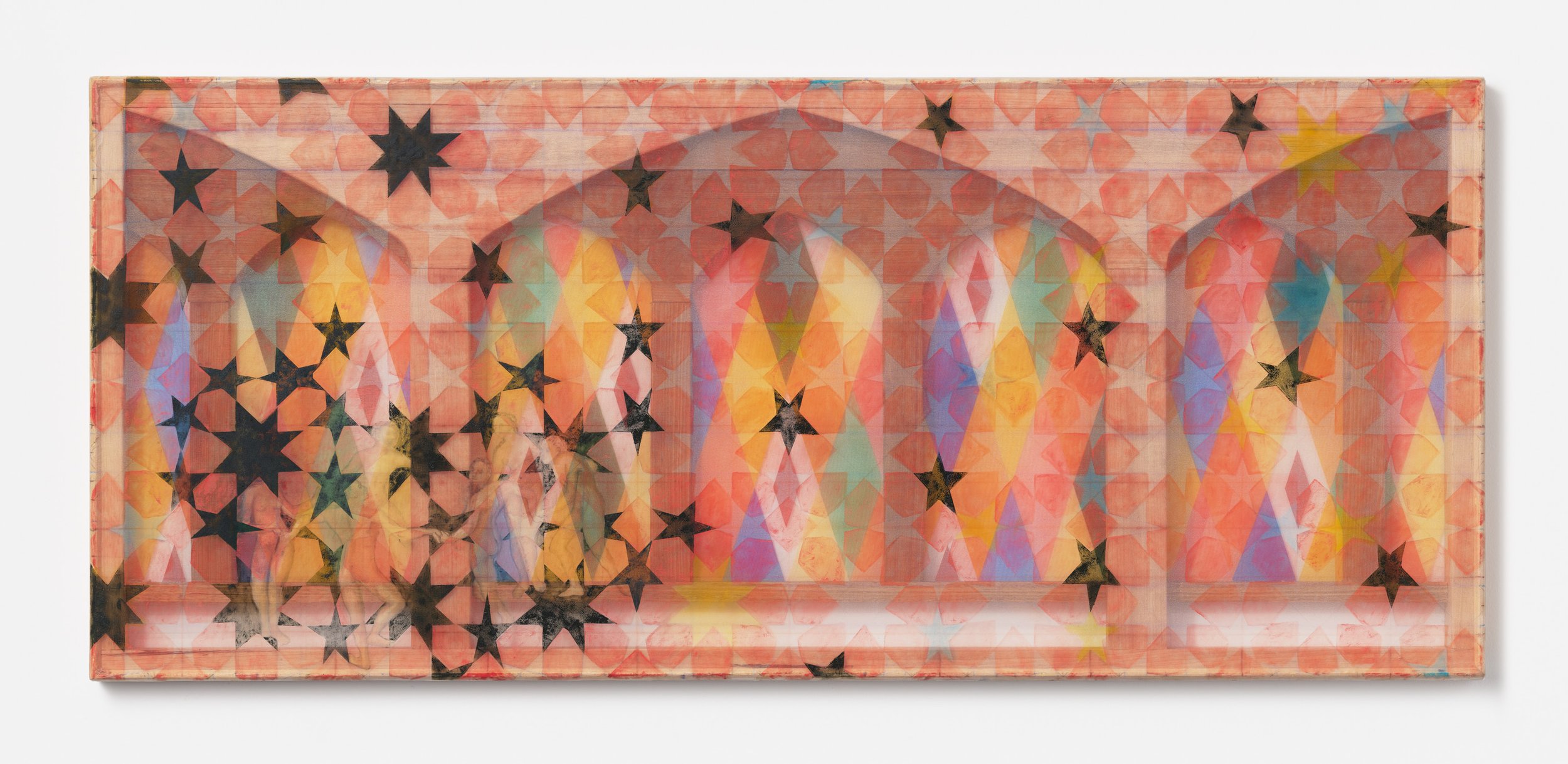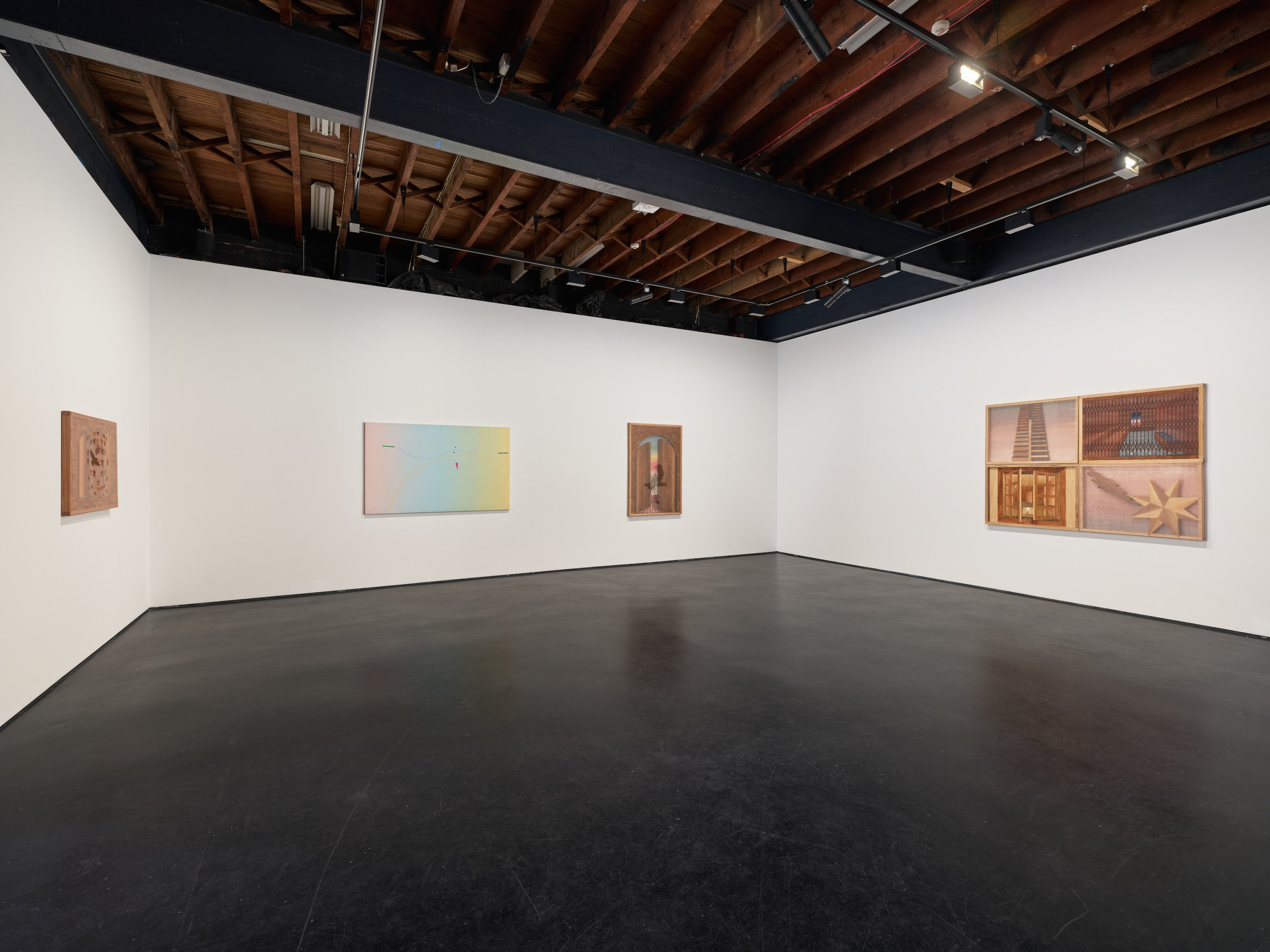
Naoise Halloran-Mackay 'Offcuts' 2024, oil, acrylic, timber, silk, organza 145 x 294 cm


Naoise Halloran-Mackay 'South lawn carpark (After Cranach),' 2024, oil on organza with hardwood support 65 x 142cm


Naoise Halloran-Mackay 'Westgate, 2024,' oil on organza with hardwood support 65 x 142cm


Naoise Halloran-Mackay 'Out to sea, 2024,' oil on organza with hardwood support 73 x 108cm


Naoise Halloran-Mackay ‘Shadow (After Hiroshige),' 2024, oil on organza with hardwood support 145 x 98cm



Naoise Halloran-Mackay 'Skylines four,' 2024, oil on board & organza - Marquetry: ply, ash, oak, messmate spotted gum, blackwood 130x210cm
The Space of Light
Virginia Cuppaidge & Naoise Halloran-Mackay
Fiona and Sidney Myer Gallery September 20 - October 26 2024
Documentation by Christo Crocker
Shown in tandem, the works of Virginia Cuppaidge (b 1943) and Naoise Halloran-Mackay (b 1997) reveal a common interest in the pictorial space of light. More specifically, these works suggest that whilst paint is their medium, their substance is light. Physically and metaphorically layered, the light in their work alludes to notions of transcendence and the sublime. Numerous veils of translucent paint point towards an understanding of light as a timeless psychological space in which sensations of warmth, isolation, intimacy and vastness are only a few of the possible embodied responses. Cuppaidge studied art in the mid to late 1960s in Sydney, whilst Halloran-Mackay graduated from the painting department at the Victorian College of the Arts in 2018. This intergenerational pairing of artists suggests the persistence of light as a continuous universal subject in art.
The two larger works presented in the current exhibition are part of Cuppaidge’s monumental Skyspace series executed in New York between 1977 and 1982. Painted almost 40 years later, the three smaller works reflect the same interest in atmospherics. In reference to the Skyspace series, curator and writer Nicola Teffer points out, ‘their radiant and sensuous surfaces reflect both the opalescent skies of New York and the expansive space and light of Australia.’[1] These dreamy fields of muted colour, sparingly punctuated with floating geometric lines and shapes suggest boundlessness and spaciousness. The luminosity of these works is the result of up to 50 faint layers of paint applied meticulously with a sponge. Each layer is left to dry completely before the next is applied. Allowing her colours to radiate with a gentle glow, Cuppaidge’s application is smooth and constrained. The transition from one colour to the next is seamless and the unbroken expanse of colour on each canvas suggests endlessness and continuity. There is a timeless quality about the Skyspace works. Cuppaidge’s paintings simultaneously reverberate and transcend the international interest in ‘geometry as design’ that characterised furniture and homewares in the 1980s.[2]
Evidenced in Grand Street Dawn (1982) and Vrinda (1982), Cuppaidge’s placement of geometric motifs is precise and decisive. Circles, triangles and lines (both curved and straight) hover effortlessly, untethered against a backdrop of lucent colour. The notion of contrast is an important aspect of the Skyspace series - clear and defined, Cuppaidge’s geometry appears suspended in an ambiguous mystical space. Like the musical compositions of John Cage and Brian Eno[3], Cuppaidge’s visual language seems grounded in a vocabulary about permanence and impermanence, possibility and impossibility, presence and absence. The music of Cage and Eno is articulated as much by the intervals between the notes as the notes themselves. Similarly, the airy contemplative quality of the Skyspace series emerges from Cuppaidge’s profound understanding of each piece of geometry and its relationship with the totality of the painting.
Writer Corinne Roberts discusses Cuppaidge’s relationship between geometry and field as suggestive of a unique landscape. ‘After her show at AM Sachs Gallery in New York, Virginia Cuppaidge began to play off hard-edge rectilinear forms against softly painted areas in such a way as to introduce a kind of landscape-horizon space peculiarly her own - but on a technical level, it is in the placement of her eccentric shapes that Cuppaidge achieves her aim “not just to paint a beautiful field, but to take the field and turn and twist it around” and forces us to locate ourselves in a point-to-point way that sets at odds our personal equilibrium and visual perception’ [4]
The references to architecture in the recent works of Naoise Halloran-Mackay articulate an interest in the notion of thresholds. Fantastic and dreamlike, the architecture in his paintings seems mystical and other worldly. His doors and windows suggest intermediary spaces between interior and exterior worlds. They can be understood as thresholds that provide relief from the physical and metaphoric confines of the building.[5] In landscape painting, the presence of architecture connects the natural world with the human made. Architectural styles often anchor the
landscape in a particular time and place. The architecture in Halloran-Mackay’s works is at once both familiar and strange. In the top right panel of Skylines four (2024) the diamond patterned security grill of the Fiona and Sidney Myer Gallery encloses a timber lined sauna with a window that reveals a twilight sky in which tiny stars illuminate a dreamlike world beyond the hard surfaces of the interior. By referencing the Victorian College of the Arts, (the location of the current exhibition which is also Halloran-Mackay’s workplace), the painting situates the viewer in an immediate reality, while subtly suggesting an imagined world and time. Similarly, Westgate (2024) contains a visual reference to the Westgate Bridge, however, Halloran-Mackay shrouds the famous Melbourne landmark in mystery via an apocalyptic circle of floating red stars. The architecture in these works can be understood as a prompt for the profound consideration of what lies beyond it – an enchanting transcendent light.
Several of Halloran-Mackay’s works involve painting on layers of silk and organza. Known for its light airy texture, the gauze-like fabric diffuses colour and creates a soft powdery effect. The transparency of gauze gives HalloranMackay the opportunity to explore the spatial quality of the picture plane. More specifically, there is depth to these works that is created by the layering of transparent painted surfaces. In this sense Halloran-Mackay allows the viewer to see the construction of his works. He makes visible his process of building up an image with a series of overlays that simultaneously obscures and defines the elements of the painting. The fullness of the figure in Shadow (After Hiroshige) 2024 is achieved in part by painting on several layers whilst its silhouette is softened by the blending of transparencies. Layers of sheer fabric enable the simultaneous depiction of a contorted human and the shadow of a raven.
The notion of revelation seems an important aspect of these works. This is manifest not only in the content of the paintings but also in their construction. The stretcher bars, normally hidden in traditional paintings on canvas, are clearly visible through the gauze, forming an integral part of the picture plane. This process of revealing that which is normally concealed can be understood as an important entry point for the consideration of Halloran-Mackay’s work. His bridges, windows, doorways and gates reveal often internalised mystical psychological realms. Echoing Jean Piaget’s theories of developmental psychology, consideration of the concrete (Halloran-Mackay’s architecture) leads to an understanding of the abstract (Halloran-Mackay’s luminous skies).[6] Raising questions about reality and existence, these works have a metaphysical quality. Their subject matter seems to extend far beyond the physical and empirical aspects of architecture to focus on the abstract and ineffable domain of feelings, intuition and deep knowing.
A profound understanding of the space of light lies at the heart of the works in this exhibition. Sublime and serene, Cuppaidge’s glorious expanses of radiating colour, punctuated by carefully calibrated geometry, evoke a sense of weightless ethereal freedom. Halloran-Mackay’s beautifully crafted paintings anticipate this freedom. His complex layering of organza undermines the permanence of architecture rendering these motifs as unfixed, transient and ever changing. The celestial drift of the works in this exhibition alludes to a perceptual space in which light is experienced as something far more than a visual phenomenon. The work of Cuppaidge and Halloran-Mackay demonstrates an understanding of light as a poetic multi-sensory space through which relationships between objects, people, places and cultures are understood in both physical and abstract terms.
Associate Professor David Sequeira
Director, Fiona and Sidney Myer Gallery
[1] https://nga.gov.au/knowmyname/artists/virginia-cuppaidge/
[2] Active 1980-1987, Memphis Milano was an Italian design and architecture fgroup founded by Ettore Sottsaa
[3] John Cage 1912-1992 composer musician, Brian Eno 1948 composer musician
[4] Corinne Robins ‘The Pluralist Era” - American Art 1968-1981, https://www.virginiacuppaidge.com/artworks/brine-5436a
[5] Thank you to Aaron Christopher Rees for raising this point at Halloran-Mackay’s artist talk Victorian College of the Arts, 19 September 2024.
[6] Jean Piaget 1896-1980, Swiss developmental psychologist